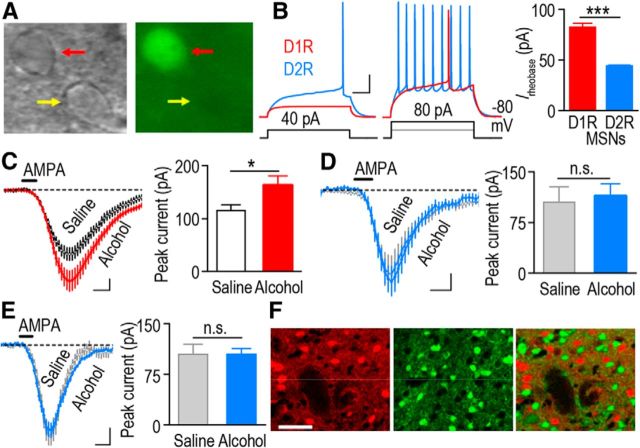Figure 1.
Repeated systemic administration of alcohol leads to a long-lasting increase in AMPA-induced current in D1R but not D2R MSNs of the DMS. A, An example of identification of DMS D1R MSNs from a D1-eGFP mouse (red arrowhead). B, Biophysical identification of D1R (red) and D2R (blue) MSNs. D1R MSNs (fluorescent cells in slices from D1-eGFP mice) exhibit a greater rheobase current compared with D2R MSNs (fluorescent cells in slices from D2-eGFP mice). ***p < 0.001; n = 3 (D1R MSNs) and 4 (D2R MSNs) from two mice in each group. C, Repeated systemic administration of alcohol leads to a long-lasting increase in AMPA-induced current in the DMS of eGFP-positive (D1R) MSNs from D1-eGFP mice. Mice were systemically administered with alcohol (2 g/kg) or saline once daily for 7 consecutive days. Sixteen hours after the last administration, DMS slices were prepared and AMPA-induced currents were measured. *p < 0.05, t test; n = 11 (D1R MSNs) and 12 (D2R MSNs) cells from five mice in each group. D–E, Repeated systemic administration of alcohol does not alter AMPA-induced current in DMS D2R MSNs, the fluorescent cells from D2-eGFP mice (D), or nonfluorescent cells from D1-eGFP mice (E); n.s., not significant, p > 0.05, t test. N = 11–12 cells from five to six mice for both groups. F, Identification of separation of D1R and D2R MSNs in the DMS. Drd1a-tdTomato (D1-tdTomato) mice were crossed with D2-eGFP mice to generate D1-tdTomato/D2-eGFP mice. A DMS section was imaged to show tdTomato-positive (left and right) and eGFP-positive (middle and right) neurons. Note that there was no overlap between tdTomato and eGFP-positive neurons (right). Calibration: B, 100 ms, 20 mV; C–E, 0.5 min, 20 pA; F, 50 μm.

